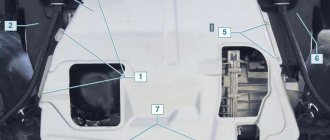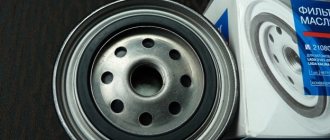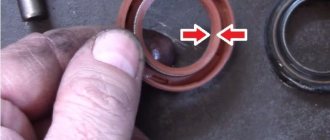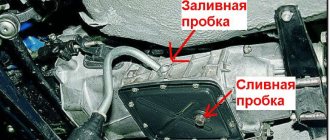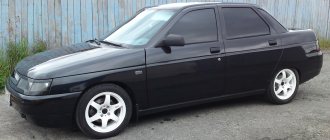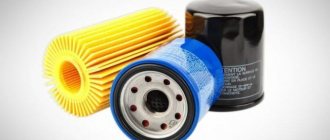The Niva SUV, in all modifications, is very popular in Russian spaces. This is due to good maintainability, low price and excellent maneuverability. To ensure reliable operation, you should undergo all maintenance on time, in particular, change the engine oil.
The VAZ 21214 engine lubrication system is designed to protect against premature wear of moving parts. It completely copes with its task, you just need to follow all the manufacturer’s recommendations.
Stages of replacing lubricant VAZ 21214
Changing the engine oil is a regulated maintenance procedure, which is prescribed in the operating instructions. There is nothing complicated about it if you clearly and carefully follow the described action plan.
The replacement operation will be the same for different modifications of the Niva car:
- VAZ 21214
- VAZ 21213
- VAZ 2121
- VAZ 2131
Our most popular engines are injection and carburetor engines, with a volume of 1.7 and 1.6 liters. The replacement process on these engines, as well as other modifications, will be the same.
Draining waste fluid
It is necessary to drain the used engine fluid when the engine is warm. This is due to the fact that heated oil is more liquid. This makes it easier for it to leak out of the thin channels of the lubrication system.
To drain old engine oil, it is advisable to drive the VAZ 21214 (Niva) onto a pit or overpass, since the drainage is done from below. If this is not possible, then the most inconvenient step will be unscrewing the drain plug. Especially if there is protection installed that will need to be removed.
When everything is ready, we proceed to the draining operation:
- Raise the hood, then find the filler neck on the engine and unscrew the cap (Fig. 1).
Fig.1 Oil filler neck - We unscrew the oil filter, which is located on the right side of the engine, on the spare wheel side. You can try to get to it from under the hood. But if the drain is made from a hole, then it will be more convenient to unscrew it from below (Fig. 2).
Fig.2 Oil filter - Now we go down under the car and place a waste container in the drainage area. You can use a cut canister or an old bucket.
- We unscrew the drain plug using a 12 hexagon, which is located in the front part of the internal combustion engine (Fig. 3).
Fig.3 Drain plug
To unscrew the filter element, it is advisable to have a special puller. If it is not available, you can try to unscrew the filter using improvised means. In this case, you can use, for example, an old alternator belt, a regular belt, a bicycle chain or a simple screwdriver.
Unscrewing the oil filter using improvised means
Using this method, you can drain the maximum amount of used oil, after which you can proceed to further actions. The main thing is not to forget, everything that we unscrewed must be put back in place.
Flushing the lubrication system
Flushing the engine on a Niva 21214, 21213 should only be carried out in exceptional cases, which include:
- Purchasing a used car when you cannot know about the quality, as well as the regularity of lubricant replacements.
- During operation, the service replacement interval was repeatedly exceeded.
- Engine operation with constant frequent overheating, which contributes to coking and other deposits.
- In cases of switching to another type, for example from synthetics to semi-synthetics.
There are several types of flushes for the Niva 2121 engine:
- Five- or seven-minute, capable of cleaning even the most difficult deposits. They must be used very carefully and strictly follow the instructions printed on the packaging. It is recommended to use them only when absolutely necessary. Since there is a high probability of causing premature wear of the sealing seals. And also clog the oil channels with particles of washed away carbon deposits.
- Special compounds that are added to the oil several hundred kilometers before the expected change. They are more gentle, but there is also a possibility of clogging of the oil channels.
- Flushing oil is the most gentle method of cleaning the engine from the inside. This composition is poured after draining the waste, the engine runs for 15-20 minutes, after which the liquid with deposits is drained. The absence of aggressive additives in the wash composition gently cleans the engine, but is not able to remove heavy contaminants.
- Regular oil that you are going to use when changing. This method is not so popular due to its high price.
Before flushing a VAZ Niva, you should weigh all the pros and cons. And also understand that it will not be possible to completely drain the liquid. Some of it will remain in the channels, which will then mix with the new oil.
Installing a filter, filling in new engine fluid
If the lubrication system of the VAZ 21214, VAZ 21213 (Niva) is sealed and does not require repair work to eliminate leaks, you can proceed to adding fresh oil. In addition to the engine oil itself, sometimes, when worn, it is recommended to change the bolt closing the drain hole. The original has article number 2101-2401046. As well as the original LADA oil filter 2105-1012005-82, from the factory, it is often installed from. If you wish, you can look at analogues on the Internet.
Consumables for maintenance
When everything is ready, let's move on to the bay:
- Replace the drain plug and replace it with a new one if necessary.
- We wipe the seat under the filter.
- We tighten and put in place the new oil filter. Pre-lubricate the rubber sealing ring with fresh oil.
- Pour new oil into the filler neck.
- We check the level on the dipstick; it should be between the MIN and MAX marks.
- We start the engine, let it run for 10-15 seconds, then turn it off.
- After 5 minutes, check the level with a dipstick and top up if necessary.
There are several opinions regarding replacing the oil filter. Many old-school owners advise filling it with new oil before installation. However, nothing is said about this in the official Lada Niva operating instructions. And also in information from global filter manufacturers it is recommended to simply lubricate the o-ring.
Chevrolet Niva
... loosen the filter with a puller (for clarity, we show the operation on the removed filter).
... loosen the filter with a puller (for clarity, we show the operation on the removed filter).
If there is no puller, we pierce the filter housing with a screwdriver (closer to the bottom, so as not to damage the engine fitting) and unscrew the filter, using the screwdriver as a lever.
Replacement frequency, what oil to fill
According to the manufacturer's regulations, service replacements of engine oil for Niva 2121 and other modifications are carried out after 10,000 kilometers or at intervals of 1 year. But some car owners consider this interval to be a little too high, recommending that it be shortened taking into account operating conditions.
At the factory, Niva models are filled with oil from different suppliers. Most often this is Petro-Canada Supreme 10W-40 or Lukoil Genesis Advanced 10W-40. But for accurate information about what is poured into your car from the factory, you should contact the feedback system of AVTOVAZ PJSC. When applying, you must indicate the year and month of manufacture of the car.
Products from other manufacturers can be used as lubricating fluid. When choosing, it is recommended to pay attention to semi-synthetics with a viscosity of 10W-40. The following motor oils are most popular among model owners:
- Lada Professional 10W-40
- Shell Helix HX7 10W-40
- Total Quartz 7000 10W-40
From this list, anyone can choose based on preference, price or love for the brand.
When using this car in winter, you should select oil taking into account the climate zone, as well as the recommendations of AvtoVAZ. Viscosity 5W-40 will allow you to operate the car down to -30°C, and 0W-40 up to -35°C.
If you use motor oil of different viscosities for winter and summer, but of the same brand and manufacturer, then flushing is unnecessary.
How much oil is in the engine lubrication system, volume table
| Model | Engine capacity | Motor marking | How many liters of oil are in the system | Original oil / factory filled |
| Niva (Lada VAZ 21214, 21213, 2121, 2131) | gasoline 1.8 | VAZ-2130 | 3.75 | Lada Professional 10W-40 / Petro-Canada Supreme 10W-40 |
| gasoline 1.7 | VAZ-21214 | |||
| VAZ-21213 | ||||
| gasoline 1.6 | VAZ-2121 | |||
| VAZ-2106 |
Chevrolet Niva
...and, unscrewing the plug manually, drain the oil.
...and, unscrewing the plug manually, drain the oil.
Attention! Be careful - the oil is hot.
Drain the oil for at least 10 minutes.
After wiping the plug, screw it on and tighten it. We remove oil leaks from the engine oil pan.
Place a container under the oil filter. Unscrew (counterclockwise) the oil filter. If this cannot be done manually...
Leaks and problems
The higher the mileage of the VAZ Niva, the more problems appear, as in principle with any car. Most often this is due to natural wear and tear of the engine, causing oil to burn. Although the manufacturer allows for a small consumption.
There can be many reasons why an engine eats oil. And in each case they can be individual. But, over the years of the model’s existence, we can talk about the most common places where leaks occur.
If the breather is spewing or throwing oil, or if there is oil in the exhaust manifold, this may indicate a serious problem with the oil rings. In this case, you can try decoking with dimexide. But it is better to use special auto chemicals designed for these purposes.
A leak from under the valve cover may be due to a worn gasket. Sometimes simply replacing the gasket does not solve the problem. Since the cover itself may have significant curvature. Therefore, in some cases it will have to be replaced.
A white emulsion in the engine or on the oil filler cap may indicate condensation. This is a common occurrence when temperatures change from minus to plus, mainly in autumn or spring.
But if the emulsion is also observed on the dipstick, then this is already a sign of more serious problems. Most often we can talk about a broken cylinder block gasket. And in rare cases, a cracked cylinder head may be to blame.
Also, with this problem, you can find oil in the expansion tank. Sometimes, simply replacing the gasket is not enough. It may be necessary to grind the head itself, and this is completely different money for repairs.
All this is general information, which may manifest itself differently on each specific vehicle, since everyone’s operating modes are different. The same applies to leak locations; it is impossible to identify the cause from a distance.
A trip to the mother-in-law - how much gas does Shevik consume?
Aloha to all fans of the Chevrolet Niva. Yesterday we came on a short cruise - we drove 300 kilometers one way to my mother-in-law. Here I would like to describe my feelings from the trip.
First, we filled up with 92 gasoline for 700 rubles (the price tag here is 31 rubles in Kirov). Drive to Rudnichny 290 km one way.
The first 90 kilometers the road is good, but the trucks constantly go non-stop, plus there are permanent settlements where the gays really like to stand.
I don’t have a radar detector yet, so I had to cut the first hundred at 70-80 km/h. I drove mostly in 4th gear, approximately 2900 rpm.
However, as soon as I left Belaya Kholunitsa, where the road was empty, I immediately drowned the kid there, since my tires were not studded, and there the road was powdery (late February), I didn’t drive too hard, I was driving at a cruising speed of 90 km/h in 5th gear.
Having reached Kirs (240 km from Kirov), it was decided to top up the little guy with gasoline, because there was still a lot left. And oppa - there is no 92 gasoline. I had to add 6 liters of 95 to get 45 km. And then I felt the difference - the car drove, even uphill in fourth gear - it pulled without problems.
So if the instructions recommend pouring 95, pour it, the only thing is that it may be of low quality. I used Lukoil, everyone praises it.
For 45 kilometers I just flew like on wings, in 5th gear the speed was 90 km/h, I didn’t even shift on hills)) However, as people say, it’s hard to start at 95 in the cold, when we arrived (north after all), it was frosty minus 28.
However, the next day they promised warming, we got ready to go back for lunch - the temperature was already -15, and the sun was warming up at the end of February. So even on 95 gasoline they started.
We drove to a local gas station and filled up with 800 rubles worth of 92nd.
Read my blog, subscribe, spring and summer are coming - there will be a lot of travel, which means there will be photo reports on fishing and searching with a metal detector. It will be interesting))
DETAILS: Recommended tire and wheel sizes for Niva 4x4 » Lada.Online
We continue work
Fill in 3.5 liters of pre-purchased oil (for 1.7 and 1.8 liter engines). After a few minutes, check the level using a dipstick. Top up if necessary. If the level is below o, add lubricant. After this, it is advisable to start the engine for a few seconds, wait a couple of minutes and check the level. There is nothing complicated about the replacement; even a beginner can do it. A minimum of tools is required. You may find the following useful:
- hexagon for unscrewing the drain plug;
- clean rags;
- metal brush for cleaning cork;
- watering can for pouring oil (optional).
All this can be found in your garage or purchased, since you will need such a tool in the future.
Lubricant selection
This issue must be approached extremely responsibly. Currently, there are a lot of high-quality lubricants for power units on store shelves. But there are also many fakes. They are the ones to be feared. Motor oil made without technology can kill a completely “living” engine in just a few thousand kilometers. Both ordinary drivers and experts in the industry speak about this.
First of all, you need to follow the manufacturer's recommendations. The manufacturer has specified all necessary tolerances. New Niva models comply with Euro-4 standards. The power unit, equipped with hydraulic compensators, needs to be filled with 5W30 synthetic motor oil of at least API, SJ class. In addition, it is necessary to take into account the temperature range in which the vehicle is operated. For northern regions, more fluid oils are used, and for southern regions, on the contrary, more viscous ones. In general, the manufacturer recommends lubricants such as Lukoil 3000, Shell Helix, Petro Canada and others. Many drivers speak positively about brands such as Lukoil and Shell, which they recommend putting into their engines.
General information
The first thing you need to do before changing the engine oil is to read the manufacturer's recommendations. The manufacturer clearly defines the scheduled maintenance periods for the power unit. But it is also necessary to focus on the operating conditions of the car, climate, etc.
The large selection of motor oils is also confusing. Currently, manufacturers are trying to expand tolerances so that one type of oil is suitable for a large number of engines. One example of the confusion with motor lubricating fluids is that until relatively recently no one bothered about this and everyone poured mineral water. Then they began to use semi-synthetics, which in their characteristics are superior to oils made on a mineral basis. Now there is a type of oil called synthetic. They have a high flash point and a good additive package. Also, the service life of such a lubricant is longer than that of mineral water. Well, what should a simple driver choose? Not everything is so simple here. Let's take a detailed look at the process of changing the oil in the Chevrolet Niva engine and determine the type of lubricant and its manufacturer.
